
April - 1963
Don't let the name fool you...
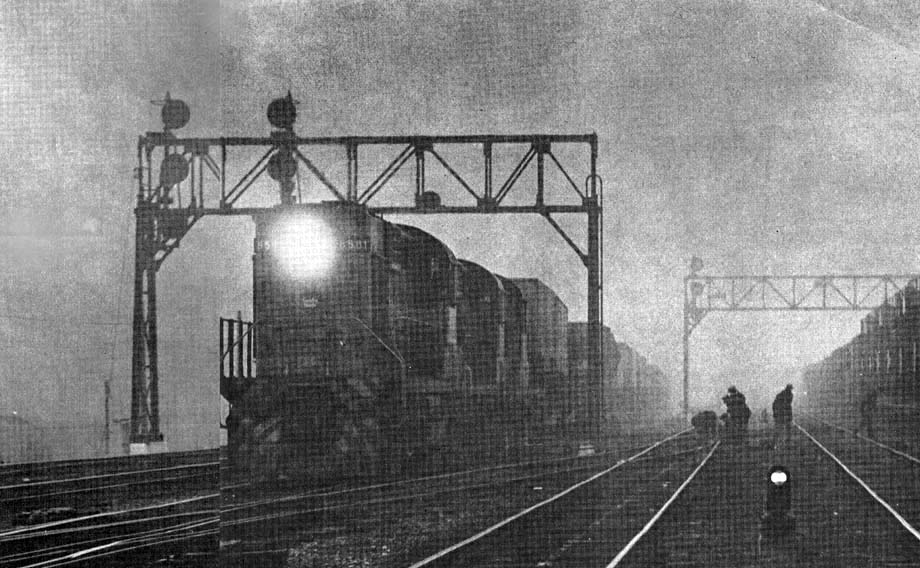
Know how the word "piggyback" was started? Few people seem to. Most dictionaries ignore it completely, as do encyclopedias, and the only reference we could find was in a century-old book on "household management." That dusty volume reports that as far back as the 17th Century the game of "pick-a-back" was a favourite in English nurseries. Object of the game was to pick someone up, preferably smaller than yourself, and tote them around on your back.
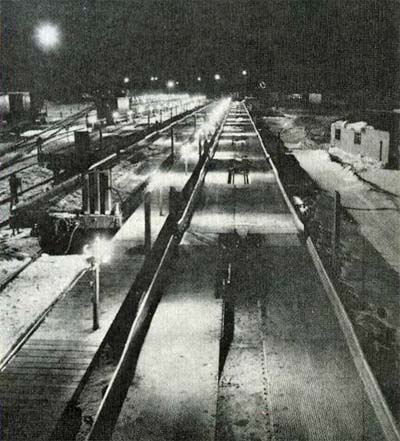
Imaginative children and intervening centuries reshaped the word into "piggyback", though the idea that fun can be had by "toting someone around on your back" seems to have lost favour with space-age children. As the game lost popularity with modern tots the meaning of the word "piggyback" underwent some drastic changes.
The new version of the old game hardly belongs in the nursery. For one thing piggyback is now "played" mostly at night, usually out of doors, and always by men.
It combines the speed of hockey, the teamwork of football, and the split-second timing of major league baseball. Neither rain nor snow, nor below zero temperatures will postpone a "game", and despite the fact that it attracts almost no spectator-fans, piggyback is played more and more each year.
Object of the "game" is to move as many truck-trailers as possible between two cities in the fastest, most economical, and practical method.
Canadian Pacific has been in the piggyback "league" for more than 10 years and fields one of the top "teams" in the world. Up to 120,000 trailers have been handled in a single year and the transportation role played by our Piggyback Services is still expanding.
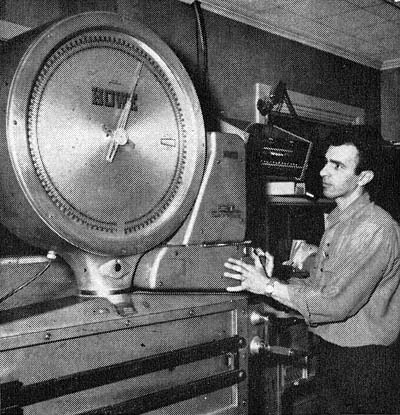
Efficient means of freight transportation are vital to a growing economy. Piggyback, both modern and efficient, is playing an increasingly important role in Canada's transportation and Canadian Pacific is playing a major role in piggybacking.
Grovehill Terminal is the main piggyback depot for the Montreal area, and it is between here and Toronto that the greatest volume of Canadian Pacific's Piggyback traffic is handled. More than 5,000 trailers move monthly along the Montreal-Toronto route, a sizable proportion of our total loadings.
Grovehill itself is 38 acres in area, and with the exception of a one-storey office building at the entrance and twelve loading tracks along one side of the lot, it is devoid of architecture. Banks of spotlights, mounted on towering poles, baseball-park style, supply night-light to the central asphalt "tarmac" area.
If the physical appearance of Grovehill is unimpressive the job that is done here more than makes up for it. Three piggyback trains are loaded, put together and sent out nightly, and the same number arrive daily for unloading. In addition, a considerable amount of piggyback traffic is received or forwarded on most regular fast freight trains.
Piggyback is essentially "pulse" work. Activity in the terminal is geared to train departure and arrival times, and any day is a series of peak periods followed by lulls.
During the lulls the terminal takes on the appearance of a huge but deserted parking lot. Few sounds, little motion, peaceful. Inside the office paper-work is being done.
But the lull soon breaks and peak periods supply enough activity, excitement, and noise to compete with a
Hollywood spectacular. Trucks arrive, trailers are detached, shunted, backed around, men run and work,
loudspeakers bark orders, lights flash, chains clink, machinery whines.
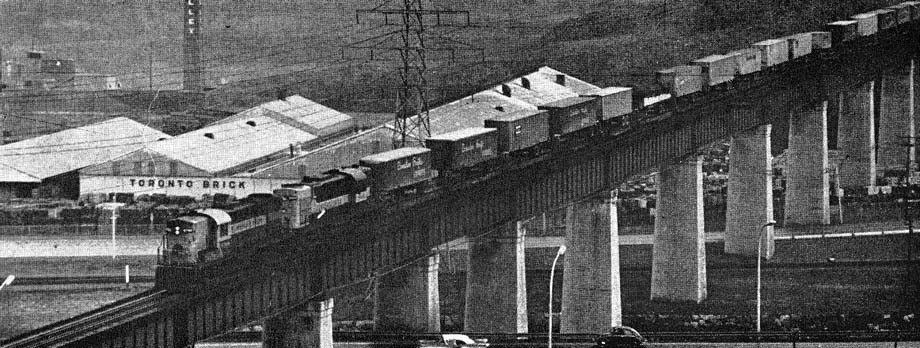
The men who work here move amid this furious activity with a purpose. What seems to the visitor's eye as
a great deal of commotion is organized effort and each man's job is an understandable part of the total effect.
Each plays a position on the team, each performs his own task.
The best way to learn about Piggyback is to follow a trailer through the handling procedure.
Trucks enter the Grovehill terminal from the main highway and stop on the scale outside the office building where their weights are automatically registered and waybills prepared. At the same time a checker looks over each trailer to make certain it is in good condition and ready for piggybacking. The driver who delivers the trailer to be piggybacked subsequently drives it down to the end of the tarmac, near the loading ramps, detaches, and leaves it there.
Canadian Pacific's Smith Transport does the actual loading of the trailers, under contract, onto specially-built piggyback flat cars, a demanding task that calls for the timing and talent of experts.
Ever rented a small trailer for the weekend, hitched it onto the back of your car, and then tried to back down your driveway? If you have experienced this perplexing problem, you can sympathize with the skill needed to back a huge trailer down a row of 10 flat cars, with about three inches to spare on either side.
Piggyback cars are not simply flat cars. Aprons that rise and drop like miniature draw bridges are installed at each end so that tractors can back trailers over a row of flatcars which are especially designed for their job and feature roller-bearing wheels, to ensure smooth performance at top speeds.
As soon as a trailer has been backed onto the farthest car from the ramp, the driver detaches it and drives
back over the piggyback cars, down the ramp, and onto the tarmac to pick up another trailer. While he continues
this routine, other drivers are loading other rows of cars, the whole train is being made up in
sections.
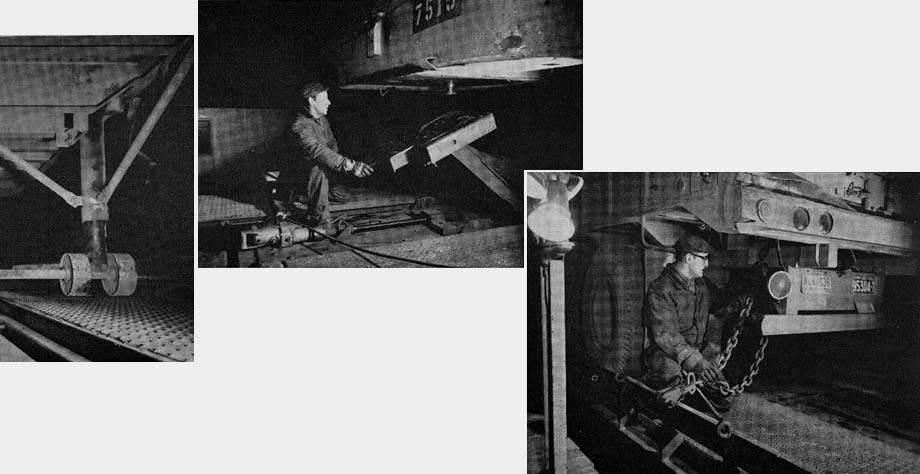
When a trailer has been freed from the tractor on a piggyback car, the "fastening" crew takes
over.
The "wrenchman"using an electric wrench raises a hitch under the front end of the trailer that will attach onto the trailer king-pin exactly as the tractor did.
A "chainman" at the rear of the trailer loosely chains the frame area on both sides of the trailer to the piggyback car, movement of the trailer is still possible (and desirable, as it guarantees a smoother ride), but the trailer is now locked solidly and securely to the piggyback car.
Entire loading operation for each trailer, from time of pick-up by the loading tractor to its final fastening to the piggyback car, is less than three minutes. Working at top speed the crews at Grovehill can load 100 trailers in little more than two hours
...but better not try to talk to them while they're doing it.
When each of the assigned ramp tracks has been loaded with trailers, the strings of cars are pulled away and marshalled together by a yard engine and crew assigned to the terminal area.
A van and diesel sent from nearby St. Luc Yard completes the train for its immediate departure.
The piggyback team, the loading drivers, the chainmen, the wrenchmen, the foremen, all of them, can now breathe a little easier.
Back to the office to attend to the paper work and perhaps a coffee. The next train isn't that far off...
 and is reprinted here with their permission. All photographs,
logos, and trademarks are the property of the Canadian Pacific Railway Company.
and is reprinted here with their permission. All photographs,
logos, and trademarks are the property of the Canadian Pacific Railway Company.